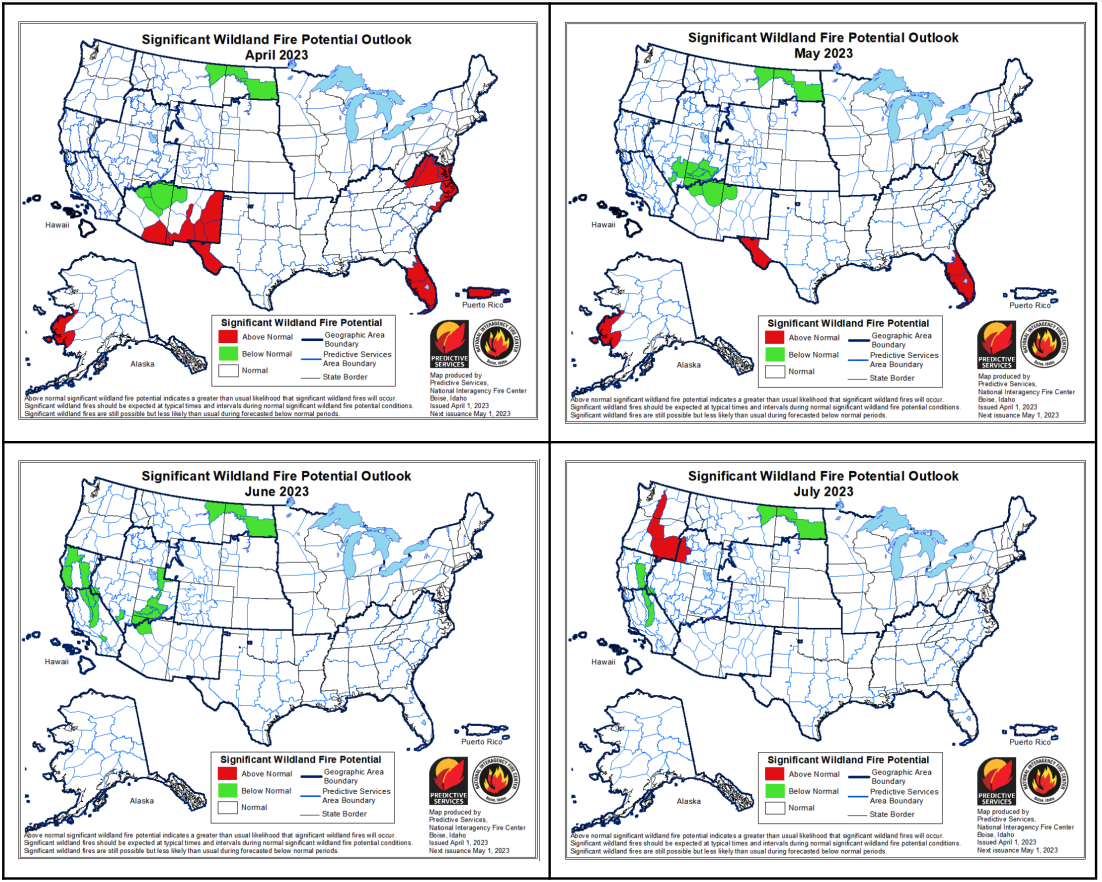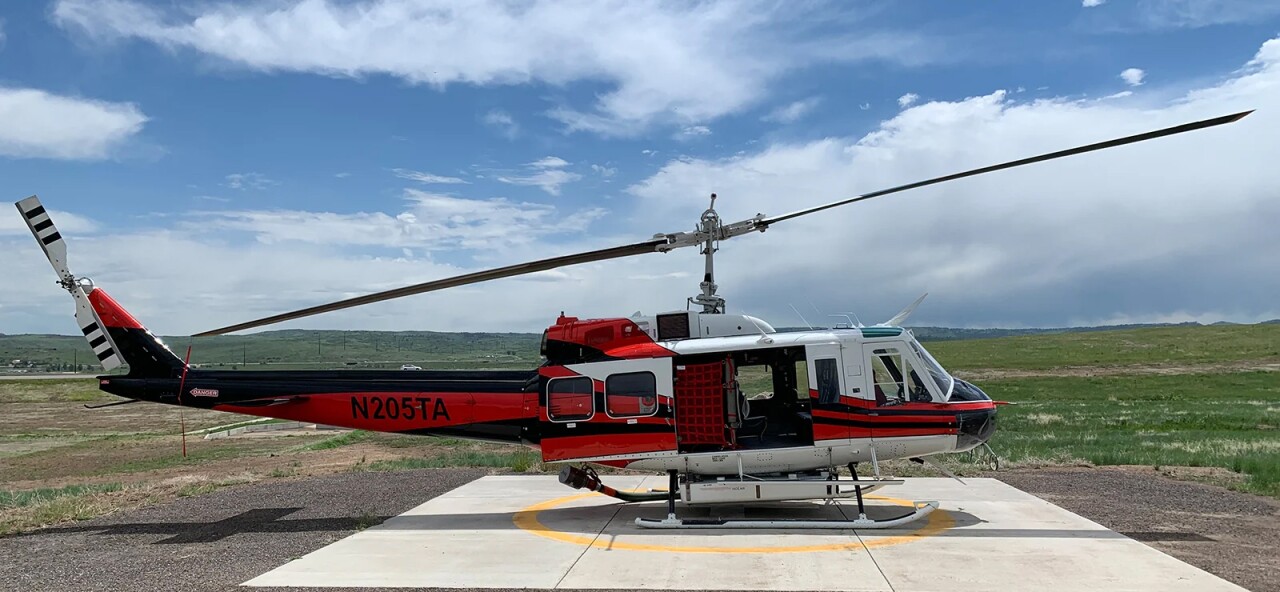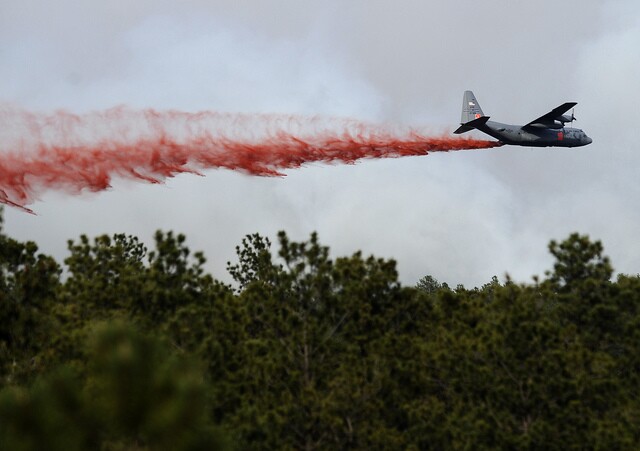CENTENNIAL, Colo. — Ahead of warming temperatures and drying conditions, experts are predicting average wildland fire activity around Colorado through the late spring and early summer, according to the newly released 2023 wildfire outlook.
However, this hardly means wildfire won't affect the state. In an average year, Colorado sees 5,500 wildfires that burn about 220,000 acres, Colorado Division of Fire Prevention and Control (DFPC) Director Mike Morgan explained during a press conference alongside Colorado Gov. Jared Polis.
Looking back at the 2016, 2017 and 2022 calendar years, which were considered below average for fire risk, there were 21 fires that were elevated to the state's responsibility.
The DFPC has used lessons gained from its previous years of firefighting along with brand new technology to create the 2023 wildfire outlook, which includes a preparedness plan. The report was released on Tuesday.
“While we saw fewer fires last year, that doesn’t change the fact that we always need to be ready for the next disaster," Gov. Polis said.
READ MORE: Denver7 wildfire coverage
“We want to make sure that across the state, we are more ready than ever before for whatever nature throws our way," he continued. "We’re in a stronger position with a record amount of fire treatment, we’re in a stronger position with the level of aerial resources that we have. But we know the difficult challenges we may face and we’re ready to face them together as a state.”
Colorado officials detail 2023 wildfire outlook
When creating a forward-looking plan on addressing wildfires, it's important to understand the past, Director Morgan said.
He said wildfire season was historically about four months long. Today, wildfire season is 78 days — almost three months — longer than in the 1970s. And still, wildland fires happen every month of the year across the state.
All 20 of the 20 largest wildfires in state history have happened in the last 20 years, with four of the largest fires burning in two fire seasons: 2018 and 2020.
Looking at 2023, Morgan said the fire forecast looks normal across Colorado for April through July.
“Historically, that means that periods of elevated fire potential at the lower elevations, especially along and east of the Front Range foothills, in southeast Colorado and in the San Luis Valley during dry and windy conditions," he added.
Those periods are expected to be short-lived.
Morgan said the areas of most concern are in southeast Colorado, where "dust bowl conditions" exist.

The outlooks show potential for above average temperatures and slightly below normal precipitation in the southern half of the state in May and June, according to the report.
While this pre-season outlook does not indicate elevated fire potential early in the season, “wildfires will still occur and large wildfires are still likely," Morgan said.
This outlook plan will be updated in July. It is subject to change when you look at the entire summer, said Colorado Department of Public Safety Executive Director Stan Hilkey.
“We get high temperature, low humidity, high winds and a lack of monsoonal moisture — that can turn this into another situation where we’re expecting more wildland fire," he said. "We want to make sure that we stay ready.”
PREVIOUS WILDFIRE OUTLOOK REPORTS:
- 2022: Wildfire 2022 outlook: Fire officials say Colorado is more prepared than ever to fight wildfires, but ‘we’re going to have some tough days’
- 2021: Colorado officials predict another year of intense wildfires after record-setting 2020
This year's plan to protect lives, property from wildfires
Officials said the DFPC's wildfire plan is part of a holistic, comprehensive approach to wildfire management that includes suppression, response, fuels, forest management and mitigation activities of all types.
"There is no silver bullet," Morgan said. "There is no one thing that will take us out of this risk and threat that we live with.”
One of the key components is early detection, which allows agencies to quickly take action to keep a fire small. This can then lead to an aggressive initial attack.
Individual preparation and responsibility is the best way a person or family can protect their neighbors from destructive wildfires, Hilkey said.
This is especially true as the number of homes in Colorado's wildland urban interface WUI is projected to increase from 300,000 to 720,000 homes by 2030, according to the DFPC report.
One of the easiest ways to stay informed is to sign up for electronic alerts. This can include calls, texts or emails from a local fire agency or sheriff's office. Hilkey also recommended residents follow their local emergency departments on social media. This applies to people who have left home to recreate in those places too, he said.
In May, which is Wildfire Awareness Month, Colorado and the U.S. Forest Service will launch a new public outreach campaign called Live Wildfire Ready. It will lay out actions that residents can take so they are always wildfire ready and their home is as protected as possible.
Colorado State Forest Service Director Matt McCombs said Live Wildfire Ready will ensure everybody in the state understands their property's risks and can connect with resources to reduce potential threats.
After phone alerts, managing fuels around a home is another easy way to prevent wildfires from reaching property. This also gives responding firefighters a leg up once they arrive at the scene, McCombs said.
“Millions of dollars are going into communities to ensure that community wildfire protection plans are updated and have the most up-to-date data and are prioritizing actions to ensure that all investments are put to their highest and best use," he said.
Tuesday's report also outlines the importance of firefighter training.
"Many of the smaller, volunteer fire departments do not have access to adequate wildland fire personal protective equipment or basic training on how to safely respond to wildland fire incidents due to lack of resources," the report reads. "DFPC offers training to fire departments across the State at no cost, but does not have enough dedicated training staff to ensure that all firefighters have access to the necessary training to keep them safe."
Polis acknowledged the shortage of firefighters in the workforce and said that training for that type of career — in addition to ones in healthcare, construction, and law enforcement — will be free at Colorado community colleges for at least the next two years once HB 23-1246 "Support In-demand Career Workforce" passes.

Local
Fort Collins duo creates first female-focused wildland firefighting uniform
Firefighters have also struggled through their own challenges away from field work.
Polis said firefighters can't always afford to live where they work, with some living 45 minutes or an hour away. The state is working on more housing options for firefighters to improve both retention and readiness, Polis said.
The Colorado Fire Commission is also aiming to identify issues and solutions for the firefighter retention issue, which is affecting many western states.
Meet Colorado's aerial firefighting equipment
While many wildfires make headlines every year, thousands of others do not.
"What a lot of Coloradans don't see are the ground and air resources that are finding and attacking new fires when they're smaller, increasing our success and limiting fire size duration costs and impacts," Morgan said.
This technique of early detection and aggressive initial attack, when successful, means most residents may not even hear about a fire.
In many cases, these quick responses involve an aerial attack or surveillance.
Colorado has two state-owned, contractor-operated fixed-wing multi-mission aircraft (MMA). Both are based at the Centennial Airport. These are used to detect new fires when they are small and provide mapping on established fires, according to the DFPC. Since 2015, MMAs have identified more than 770 previously undetected fires, according to the outlook report. In 2021, the MMA program located 205 fires, including 38 fires in a single day on Aug. 27, 2021.
These aircraft are available to the state every day of the year and can fly to almost anywhere in the state 45 minutes after launching.
In addition to these two MMA, Colorado also has an exclusive use contract for one Large Airtanker (LAT) for 110 days each year. The LAT can deliver up to 3,000 gallons of fire retardant to a blaze, according to the DFPC.
The single LAT is based at the Rocky Mountain Metropolitan Airport in Broomfield, but can be moved to other bases.
Colorado also has contracts for two high-performance single engine airtankers (SEAT), which are each available for 240 days per year. They are both based at the Northern Colorado Regional Airport. While firefighting, they can deliver up to 800 gallons of fire retardant, suppression or foam, according to the DFPC.
In addition to fixed-wing aircraft, the state has contracts for firefighting helicopters. One is an exclusive use contract for two high-performance standard category Type 2 helicopters, each for 230 days a year. The second is an exclusive use contract for one restricted category Type 1 helicopter for 110 days per year.
Both of these can help by delivering water, suppression and supplies.
And there's a partnership so if a resource is needed somewhere in the state, regardless of contracts and ownership, an aircraft can respond.
"We are, I believe, the only state in the nation that has a 24-hour mutual aid agreement for all resources, regardless of who's contracted with that. We send the closest available resource, whether that be a state-owned asset or a USDA asset or a DOI asset," Morgan said.
Local governments are also building up aerial defenses. For example, Douglas County recently announced it has a new tool in its firefighting arsenal after the Board of Douglas County Commissioners committed more than $1.5 million to the county's 2023 wildland fire aerial firefighting contracts, ensuring the county has aerial support anytime a fire breaks out.

Local
Douglas County approves contract for exclusive use of a Type 2 helicopter
Douglas County will have 153 days — June 1 through Oct. 31, 2023, historically the months of highest fire frequency and severity in the county — of exclusive use of a Type 2 helicopter thanks to a contract with Trans Aero LTD. The helicopter will be able to transport 300 gallons of water to a fire. The contract includes options to extend it annually for an additional four terms.
Looking ahead, Colorado will also soon have its own Firehawk, a newly manufactured S-70M Black Hawk from Sikorsky that was outfitted for firefighting. It will be able to respond anywhere in the state within an hour of takeoff, which is one of its strongest assets, Morgan said.
"The state-owned Firehawk will increase DFPC's capacity to respond to fires on a year-round basis and set response priorities based upon Colorado's needs first," he said.
Polis added that it can fly in 70 mph winds.
In late March, DFPC said United Rotorcraft experienced delays, which affected the Firehawk's expected delivery date, which is now expected around May 31.
Once it is ready for use, which should be by July 1, it will be available every day of the year.
The rise of technology in firefighting
Technology has grown to become a huge part of fighting wildfires across the state and beyond.
In June 2022, Denver7 featured the scientists at the National Center for Atmospheric Research (NCAR) in Boulder who developed artificial intelligence to identify the locations and amounts of dead or dying trees and vegetation in Colorado forests, which burn quickly and, therefore, cause wildfires to spread faster.
“You can imagine that it takes a lot of time and effort to assemble that data, so it is only published about every five years,” said Amy DeCastro, lead researcher for the study. “Our AI-based method is able to update the vegetation maps during those times between publication and accurately capture any disturbance to the vegetation that may have happened in the meantime, like drought and beetle infestation.”
READ MORE: Denver7 drought coverage
In January, the Associated Press reported that Colorado lawmakers discussed creating a $2 million pilot program to mount cameras on mountaintops in high-risk locations. An artificial intelligence program developed by Pano AI would analyze the images and sounds from cameras with 10-mile radiuses in hopes of detecting something that could signal the start of a blaze.

Wildfire
Colorado lawmakers look to AI to detect wildfires early
The Telluride Fire Protection District partnered with Pano AI in March for the year-long pilot program, according to The Denver Post. It was previously deployed in Aspen, Vail, Beaver Creek, the Roaring Fork Valley, the Boulder area, as reported by the Telluride Daily Planet.
Some technologies, just as powerful, can be held in your palm, like the smartphone app Wildland Fire Team Awareness Kit, shortened as TAK or WFTAK.
In October 2022, the Center of Excellence for Advanced Technology Aerial Firefighting (CoE) — created in 2014 as DFPC's research and development organization — partnered with the U.S. Forest Service on a five-year, $1.6 million agreement to develop these tech advancements, including this app.
This app can provide up-to-the-second tracking and mapping information, plus integrations of sensors and cameras, for firefighters.
A pilot program for TAK was used during the 32,000-acre Grizzly Creek Fire in 2020 and CoE reported that all firefighters who used the app "stated that TAK improved their situational awareness."
In addition to intense machines and technologically advanced resources, Colorado also has Arson K9 JoJo, an accelerant detection specialist. She's a graduate of the State Farm Arson Dog Training Program, which started in 1993.
She joined Colorado's team in 2021.
Federal assistance for future Colorado wildfires
Early this year, the Biden administration announced that the United States would direct $930 million toward reducing wildfire dangers in 10 western states — including Colorado — by clearing trees and underbrush from national forests.
The U.S. Forest Service is trying to prevent out-of-control fires that start on public lands from raging through communities, but in an interview with The Associated Press, U.S. Agriculture Secretary Tom Vilsack acknowledged that the shortage of workers that's been plaguing other sectors of the economy is hindering the agency's wildfire efforts.

National
Labor shortage compounds federal firefighters' staffing woes
The AP reported that the Biden administration plan aims to lower wildfire risks across about 80,000 square miles of public and private lands over the next decade. Vilsack said in the past 10 years, wildfires have burned about 115,000 square miles — an area larger than Arizona.
The administration's announcement came about a month after Deputy Secretary of the Interior Tommy Beaudreau, during a visit to Colorado, announced the first allocation in the Bipartisan Infrastructure Law for 2023 to support wildland fire management.
This allotment totaled $228 million nationwide. Of that, $7 million was set to go to Colorado in fiscal year 2023. Beaudreau said these funds would support multiple aspects of wildfire management, including:
- Pay increases for federal firefighters
- New training opportunities
- Fuels management work to reduce fire risk
- Burned area rehabilitation to help speed recovery after fires
- Increased funding for science that will examine the impacts of climate change on fire management




